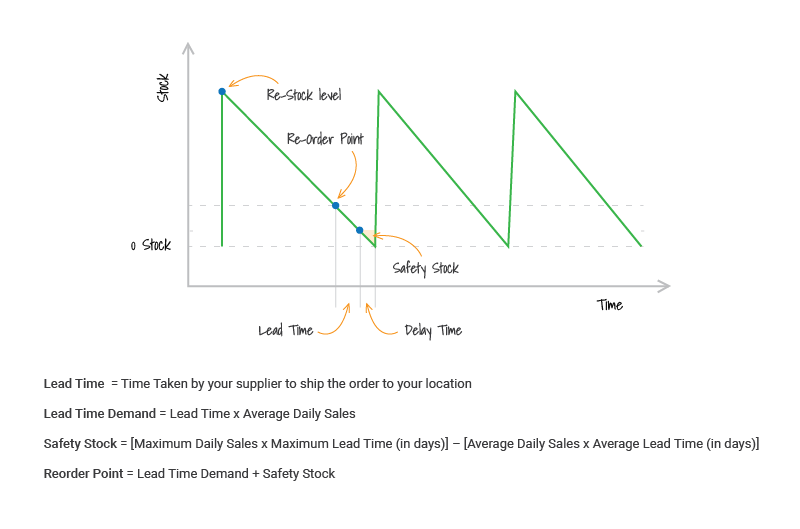When it comes to inventory management, there’s no getting around the math! Calculating the reorder point, safety stock and average order quantity over time can help you avoid hoarding excess inventory and free up your working capital.
Let’s say you recently expanded your business and a couple of your new products have been selling like hot cakes. While this certainly means your revenue is increasing rapidly, your inventory levels are depleting simultaneously too.
The biggest challenge in such a situation is figuring out the right point at which you need to reorder each of the products before they go out of stock. Order too soon and your storage costs go up. Order too late and you’re left handling disgruntled customers who’ll probably buy the products from someone else.
Calculating your reorder point for these products accurately and frequently can help you stay on top of the inventory game.
What Is Reorder Point?
As your business grows, your products start increasing in number and it becomes hard to figure out when to restock them individually. So, you calculate and rely on what is known as the reorder point, which is essentially the amount of inventory for every product that you don’t want to go below. The right reorder point gives you enough time to place a new order for stock before your inventory becomes too low.
Reorder Point Definition: The minimum inventory level for a product, at which point you raise a purchase order for that product.
If you calculate the ideal reorder point for a product, you’ll always know when to place an order for more inventory while preventing capital from being tied up in maintaining excess stock.
Steps To Take Before Calculating Reorder Point
Before calculating the reorder point for a product, you need to first:
- Calculate the lead time demand for it (in days), and
- Measure the safety stock in terms of how long it might last in an emergency (in days)
Once you have arrived at these values, all you need to do is add the two to get the reorder point.
Calculating the lead time demand is important because you will have to wait before your stock is replenished by your supplier. Not just that, you’ll also need to continue catering to your customers during this time.
Likewise, knowing your safety stock quantity is also crucial because it will help you tackle emergencies. It works like a trump card of sorts, which also means you shouldn’t have to dip into it all the time.
Once you have both these quantities, add them and you’ll arrive at your ideal reorder point.
Arriving At Lead Time Demand For Reorder Point Planning
It’s a given that any new stock you order will not arrive right away. Your supplier needs time to pack and ship it to you. This waiting time from when you place an order for the stock to when the order is fulfilled is known as the lead time.
To understand this better, let’s discuss an example. Imagine that you are a retailer of women’s shirts. Your supplier takes about 5 days to pick up the shirts from the warehouse and pack it. Then, it takes about 15 days for them to ship the shirts from their location to yours.
So, Lead Time = 5 + 15 = 20 days
Considering that it takes 20 days for you to receive a new shipment of shirts, you will need to have enough stock to cover these 20 days of sales from when you raise a purchase order.
But, to have an idea of how much stock you will need during the time, you will need to know what the demand is like during this period in addition to the lead time.
Considering the same example from above and assuming that you sell an average of 930 shirts a month, you’ll be selling an average of 930/31 = 30 shirts a day.
Once you have these values, you calculate your lead time demand with the formula
Lead Time Demand = Lead Time x Average Daily Sales
In this particular example,
Lead Time Demand = 20 x 30 = 600 shirts
So, for you to manage your sales until your next shipment arrives, you will need 600 shirts as long as there are no unexpected hiccups.
Safety Stock Calculation For Reorder Point Formula
While running a retail business, you’re bound to face unforeseen circumstances every now and then – especially when it comes to inventory. This could be the result of:
- a sudden increase in demand, which can lead to sales shooting up dramatically, or
- issues from your supplier’s end which lead to a delay in them sending across stock to you
In such situations, you will need to rely on your safety stock. This is essentially the excess stock you must keep to fulfill orders and cater to sales during emergencies. While it would be ideal to have enough safety stock to avoid a stockout, you don’t want to have too much either.
How much safety stock do you need?
Let’s use the same example from above to get a better picture. We’ve established that, on average, you sell about 30 shirts a day. But, during weekends, you’re likely to sell more – let’s say about 40 shirts. And while the lead time is usually 20 days, when your supplier is not available at their desk it could go up to, say, 25 days.
Once you have these values, you can calculate your safety stock using the formula below:
Safety Stock = [Maximum Daily Sales x Maximum Lead Time (in days)] – [Average Daily Sales x Average Lead Time (in days)]
In this case, the safety stock you’d need is
Safety Stock = (40 x 25) – (30 x 20) = 1000 – 600 = 400 shirts
So, you will need to maintain a safety stock of 400 shirts to cater to customers.
During a good week, you will most likely sell about 230 shirts. That’s 30 each day on weekdays and 40 each day during weekends. All in all, you will have sufficient stock that will last you close to 2 weeks (400/230 = 1.73 weeks).
So, you can use your safety stock to fulfill sudden demands while running low on inventory. Also, if you sell seasonal products, you will need to adjust your safety stock levels to factor in peak demand. Once the peak season is over, you can revert to your regular safety stock levels to avoid excess storing costs.
How To Calculate Reorder Point
Once you’ve calculated the lead time demand and safety stock for a product, you can calculate the reorder point for it using the formula below:
Reorder Point = Lead Time Demand + Safety Stock
So, in the example used previously,
Reorder Point = 600 + 400 = 1000 shirts


This means that once your stock level hits 1000 shirts, you will need to reorder from your supplier.
While waiting for your next order of 600 shirts (lead time demand), you will have 400 shirts (safety stock) to keep sales going even in the event of an unforeseen circumstance.
Reorder point planning is extremely vital for inventory management. When you set it to an optimum level, you avoid spending too much on unnecessary storage costs. You also ensure that you have enough inventory to keep sales going. Using an inventory management system and entering the reorder point for each product can help you automate your purchase orders.
Request Demo
thank you
thank you
thank you
Request Demo
window.IS_INDIA = 0;window.USER_COUNTRY = 'China';window.USER_CITY = 'Hangzhou';window.USER_COUNTRY_ISO = 'CN';
Armed with a degree and a pen, loves to tell stories. When not telling stories, she also works. Hard to decide which one she likes more.
(function(d){var s=d.createElement('script');s.type='text/javascript';s.src='https://a.omappapi.com/app/js/api.min.js';s.async=true;s.dataset.campaign='cxecxy09nlvnnyvfiqjf';s.dataset.user='22867';d.getElementsByTagName('head')[0].appendChild(s);})(document);
,



